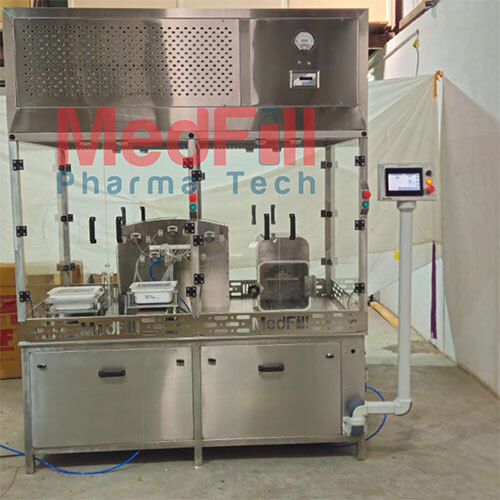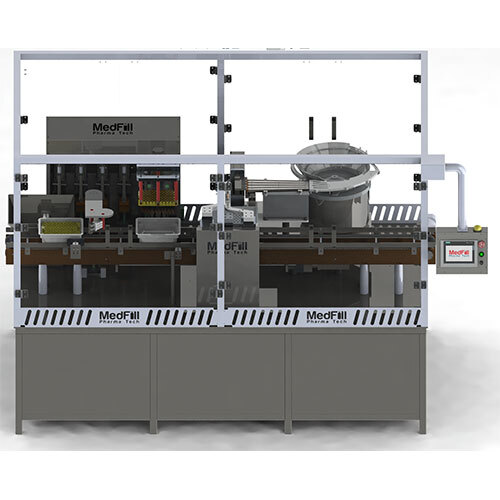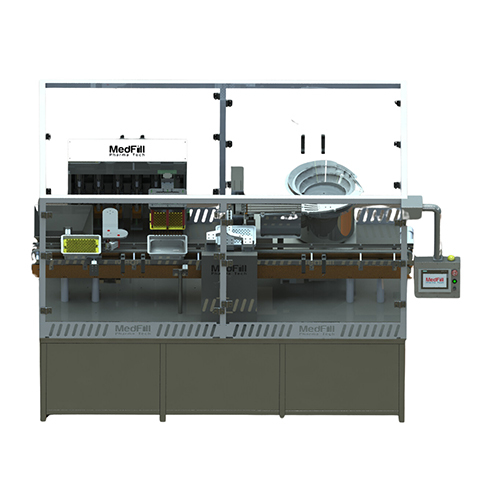Semi Automatic PFS Machine
Product Details:
- Shape Square
- Phase Single
- Product Type SEMI AUTOMATIC PFS MACHINE
- Material Stainless Steel Alloy
- Computerized No
- Automatic Yes
- Touch Screen No
- Click to View more
Semi Automatic PFS Machine Price And Quantity
- 500000.0 INR/Piece
- 1 Piece
Semi Automatic PFS Machine Product Specifications
- Yes
- No
- Square
- 1 Year
- No
- Single
- 220-440 Volt (v)
- Stainless Steel Alloy
- Silver
- SEMI AUTOMATIC PFS MACHINE
Semi Automatic PFS Machine Trade Information
- 1 Piece Per Month
- 45 Days
- No
- Asia
- All India
- No
Product Description
Our Semi-Automatic Pre-Filled Syringe (PFS) Filling & Stoppering Machine is a high-precision solution tailored for small to medium-scale pharmaceutical production. It combines flexibility, accuracy, and robust design, meeting the needs of injectable manufacturing with operator-friendly handling.
Key Features:
Filling Options:
- Rotary Syringe Pump: Ideal for high-viscosity liquids with consistent and robust performance.
- Peristaltic Pump: Suitable for sterile and clean filling, quick tubing changeover, and compatible with small-volume dosing.
Filling System:
- 5-Head high-accuracy pump configuration (customizable as per need).
- Servo-driven filling for superior accuracy and repeatability.
- Filling range: 0.2ml to 5ml with 1% accuracy.
Stoppering System:
- Advanced Vacuum Chamber Technology for accurate and gentle stopper insertion.
- Nitrogen Purging feature prior to stoppering for enhanced product stability and reduced oxidation.
Syringe Handling:
- Designed for nested syringes with easy manual loading and unloading.
- Ensures minimal human intervention in the critical zone.
Control System:
- Intuitive HMI System for user-friendly operation and parameter control.
- Alarm notifications for critical faults and process safety.
Servo-Driven Mechanism:
- X-Y Servo Table for precise syringe positioning.
- Adjustable height mechanism for different syringe formats.
Compliance & Safety:
- Designed as per cGMP standards.
- Can be configured with 21 CFR Part 11 compliance for data integrity and audit trails.
Custom Integration Options:
- Optional integration with labeling and Plunging machinery, or batch recording systems.
- Format-free design for quick changeover and minimal downtime.
Frequently Asked Questions (FAQs)
What kind of filling options are available in this machine?
Answer: This machine supports two types of filling mechanisms:
Rotary Syringe Pump Suitable for high-viscosity liquids and provides mechanical robustness.
Peristaltic Pump Ideal for sterile applications, allows easy tubing changeover, and minimizes product contact.
How does the vacuum chamber-based stoppering work?
Answer:In vacuum chamber-based stoppering, nested syringes are placed inside a sealed chamber. A vacuum is applied to remove air, and then the rubber stopper is gently placed on top of each syringe. This technique ensures consistent stopper insertion without air entrapment and is especially suitable for aseptic and nitrogen-purged processes.
What is the difference between a Semi-Automatic and a Fully Automatic Pipe In-Out Type PFS Machine?
Answer:Semi-Automatic PFS Machine: Requires manual loading and unloading of nested syringes. Ideal for small to medium-scale production or R&D setups.
Fully Automatic Pipe In-Out Type PFS Machine: Features automatic handling of nests, filling, stoppering, and movement across stations without operator intervention. Suitable for large-scale and high-speed production lines.
Which stoppering method is better: Pipe In-Out or Vacuum Chamber-based? How should I choose?
Answer:Vacuum Chamber-Based Stoppering is recommended for high-precision, aseptic environments and nitrogen-purged applications. It ensures no air bubble entrapment.
Pipe In-Out Type Stoppering is a cost-effective solution for higher speed requirements but may not offer the same level of air removal or uniformity.
Selection Tip: Choose Vacuum Chamber for high-quality and injectable-critical products. Choose Pipe In-Out for cost-effective, high-throughput lines where absolute vacuum is not required.
Which filling option is better: Peristaltic or Rotary Syringe?
Answer: Peristaltic Pump: Preferred for sterile processes, low-volume fills, and easy changeover between products. Minimal risk of contamination since the liquid only contacts the tubing.
Rotary Syringe Pump: Offers precise volumetric filling and is better for high-viscosity liquids but requires more maintenance and cleaning.

Price:
- 50
- 100
- 200
- 250
- 500
- 1000+







 English
English Spanish
Spanish French
French German
German Italian
Italian Chinese (Simplified)
Chinese (Simplified) Japanese
Japanese Korean
Korean Arabic
Arabic Portuguese
Portuguese